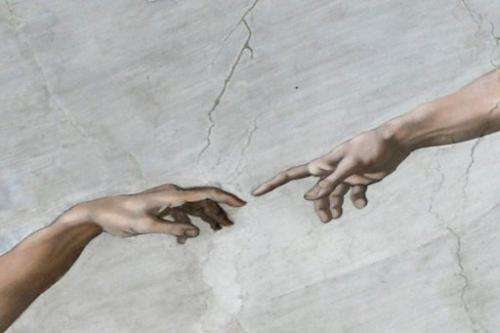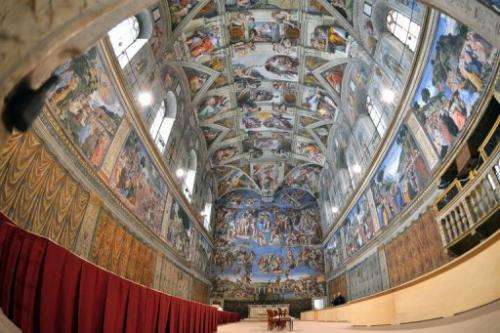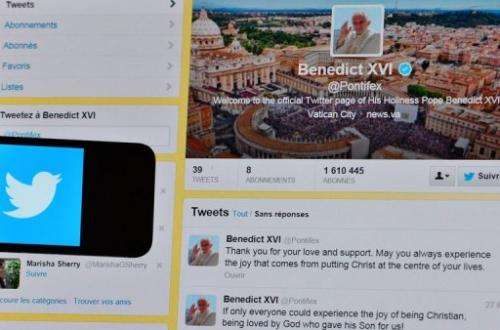Papal conclave: Ancient ritual and high-tech security

There will be no tweeting the results of the papal election from inside the secret conclave: cardinals withdrawing to choose a new pope enter a world apart where ancient ritual meets high-tech security.
Red-robed cardinals in all their finery chant to invoke God's guidance as they process into the Sistine Chapel, which will be swept for bugs in a bid to keep would-be spies from spilling conclave secrets to the world.
The conclave, named after the Latin phrase meaning "with key", comes eight centuries after the first lock-in, when protesters angry at nearly three years of indecision fed cardinals bread and water until they had made up their minds.
While many things have changed since then, the element of secrecy has not.
Under rules to make sure that not even the merest hint emerges from the cardinals' deliberations, those who betray the conclave face excommunication.
The cardinals too are cut off from any information filtering in from outside until the conclave is over.
The centuries-old bid to eliminate the influence of meddling outsiders like the Roman nobility on papal elections was strengthened by pope John Paul II.
"Careful and stringent checks must be made... in order to ensure that no audiovisual equipment has been secretly installed in these areas for recording and transmission to the outside," the pope ordered in his 1996 document.
Benedict XVI may have revolutionised the Vatican's communication approach by opening a Twitter account and encouraging media-savvy cardinals to tweet, but here the language is Latin and the tool the humble pen.
A system is installed under Michelangelo's magnificent fresco of Christ delivering the Last Judgement to scramble any mobile phone communications with the world outside: no Twitter, no Facebook, no smartphone conclave apps.

A system designed to regulate moisture in the chapel is removed, for fear bugs could have been planted at a previous moment.
The Renaissance chapel, one of the most visited sites in the world, is lined with rows of cloth-draped tables and electors draw lots to see who sits where.
The "Princes of the Church" swear oaths of secrecy, before the master of Vatican liturgical ceremonies intones "Extra Omnes" ("Everyone Out"), and all non-voters leave while the cardinals hear a spiritual meditation on their task.
Even Vatican staff, from doctors to elevator operators, must swear oaths, and the lifts and nearby bathrooms will be swept for bugs.
To vote, cardinals write their choice on a piece of paper, often under the Latin heading "Eligo in Summum Pontificem" ("I elect as Supreme Pontiff").
When casting his ballot, the cardinal slides the folded paper into a specially designed urn while invoking God as his witness in Latin.
At the end of the vote, counting can begin once the scrutineers have checked that the number of votes conforms to the number of electors.
There is no electronic voting machine or risk of e-fraud: as the votes are counted, a scrutineer calls out the name and a needle and thread is passed through each ballot. At the end of the count, the thread is knotted.
The electors vote four times a day until a two-thirds consensus emerges.
Historical methods intended to speed up the vote have been ditched, and the cardinals will not be forced to remain holed up each night in the ballot room.
They have been given an upgrade on the previous spartan lodgings given to electors within the Vatican, where they shared toilets and other facilities.
Now they enjoy hotel-like accommodation—with individual bathrooms—in a purpose-built residence, but even there security is tight: they have no radios, televisions, newspapers or any means of communicating with the world outside.
There will be no Internet either and smartphones are strictly off limits—on pain of excommunication for breaking the secrecy of the conclave.

Should any of the cardinals be ill and unable to attend the vote, they can drop their ballot through a slit in a locked box brought to them in their rooms at the Vatican by selected "infirmarii" cardinals, trusted not to peek.
Once the vote is in, the ballot papers are burnt: black smoke curling from the Vatican's chimney means no decision has been made, white means a new pope has been elected.
The smoke was traditionally blackened by adding damp straw to the fire, but following confusion over several instances of grey smoke, the Vatican now adds a chemical to the fire to make sure the smoke emerges the correct colour.
And just in case even modern chemicals prove unreliable, the bells of St. Peter's Basilica will peal to tell the world "Habemus Papam"—"We have a pope" before the chosen one emerges onto a balcony over St Peter's Square.
(c) 2013 AFP



















